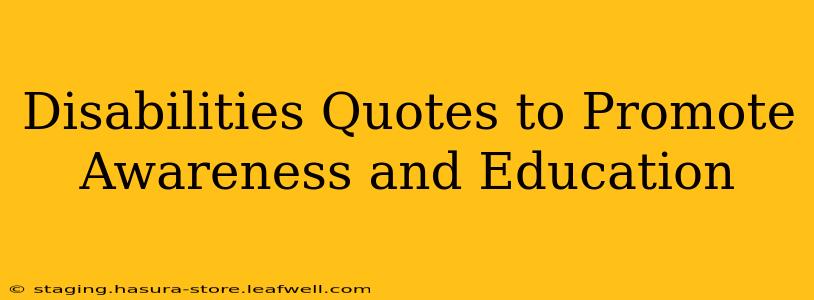Disabilities affect a significant portion of the global population, impacting individuals, families, and communities. Understanding and celebrating the diversity of abilities is crucial for fostering inclusivity and creating a more equitable society. This article explores powerful quotes about disabilities, aiming to promote awareness and education, and answer common questions about disability inclusion. We'll delve into the importance of person-first language, discuss the challenges faced by disabled individuals, and highlight the vital role of education in building a more compassionate and understanding world.
What are some powerful quotes about disabilities that promote awareness and acceptance?
Many inspiring quotes highlight the resilience, strength, and contributions of people with disabilities. Here are a few examples:
-
"Disability is not inability." This concise and impactful statement challenges the common misconception that a disability equates to a lack of ability. It emphasizes the potential and capabilities that exist within individuals, regardless of their challenges.
-
"The only disability in life is a bad attitude." This quote, often attributed to Scott Hamilton, highlights the importance of mindset. While physical or mental challenges exist, a positive attitude can significantly impact one's ability to overcome obstacles and thrive.
-
"We are all different. That’s what makes us beautiful." This quote emphasizes the inherent beauty of diversity. Embracing differences, including disabilities, is essential for building a truly inclusive society.
What is the importance of using person-first language when discussing disabilities?
Person-first language prioritizes the individual before their disability. Instead of saying "disabled person," we say "person with a disability." This subtle shift in language emphasizes the person's identity as an individual, not solely defined by their disability. While some individuals prefer identity-first language ("disabled person"), person-first language remains widely accepted as a respectful approach. The key is to respect individual preferences and use language that centers the person.
What are some common misconceptions about people with disabilities?
Several misconceptions surround disabilities, often stemming from a lack of understanding and exposure. These include:
-
The assumption that all disabilities are visible. Many disabilities are invisible, affecting cognitive functions, mental health, or chronic pain, and are not immediately apparent.
-
The belief that people with disabilities require constant assistance. While some individuals may require support, many are independent and capable of living fulfilling lives with minimal assistance.
-
The inaccurate belief that disability is solely a medical issue. Disability is a complex interplay of individual challenges, societal barriers, and environmental factors.
Addressing these misconceptions through education is vital in fostering a more inclusive and understanding society.
How can education help create a more inclusive environment for people with disabilities?
Education plays a crucial role in building an inclusive environment. This includes:
-
Comprehensive disability awareness programs in schools and workplaces. These programs should go beyond basic awareness, promoting empathy, understanding, and respect.
-
Accessible learning environments for students with disabilities, providing appropriate accommodations and support.
-
Inclusive curriculum that accurately represents the diversity of abilities and celebrates the contributions of people with disabilities.
-
Training for educators and employers on how to effectively support and work with individuals with disabilities.
What are the challenges faced by people with disabilities in society?
People with disabilities often face numerous societal barriers, including:
-
Accessibility issues: Lack of accessible transportation, buildings, and technology limits participation and independence.
-
Discrimination and prejudice: Negative attitudes and biases can lead to exclusion and inequality.
-
Financial hardship: The costs associated with disability-related support and healthcare can be significant.
-
Limited employment opportunities: People with disabilities often face significant employment barriers.
How can we promote greater inclusion and understanding?
Promoting inclusion requires a multi-faceted approach:
-
Amplifying the voices of disabled individuals: Creating platforms for sharing their experiences and perspectives.
-
Celebrating achievements and contributions: Highlighting the successes and talents of people with disabilities.
-
Advocating for policy changes: Supporting legislation and initiatives that promote accessibility and equal rights.
-
Engaging in respectful and open conversations: Discussing disability openly and honestly helps break down stereotypes and build empathy.
By actively promoting awareness, challenging misconceptions, and fostering inclusion, we can create a more equitable and compassionate world for people with disabilities. The quotes above serve as powerful reminders of the resilience, strength, and contributions of this vital segment of our population. Let's continue to learn, grow, and build a future where everyone has the opportunity to thrive.

